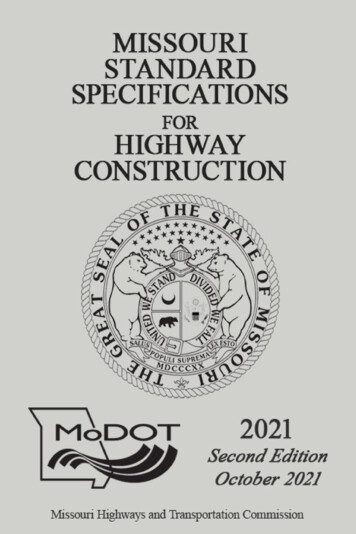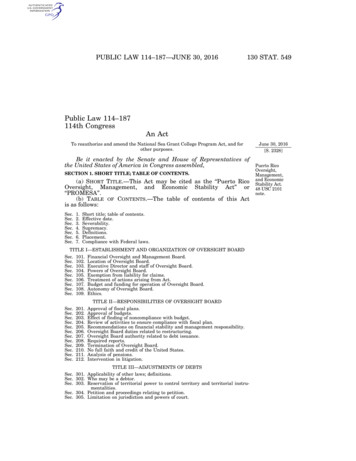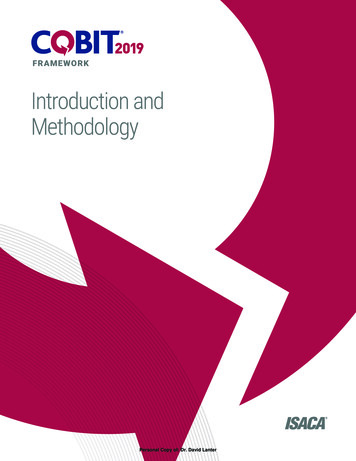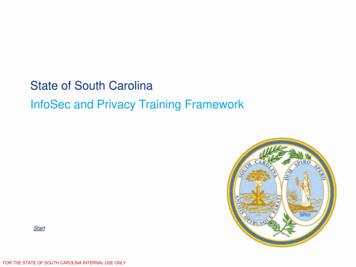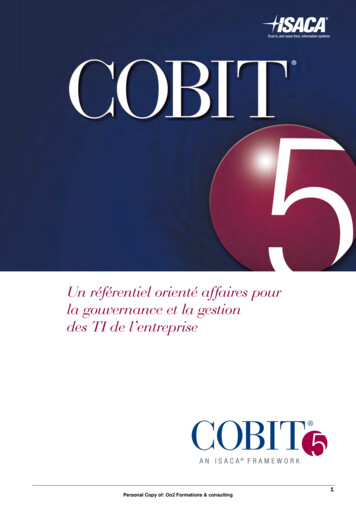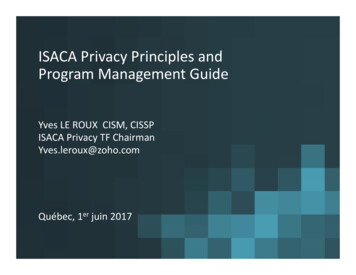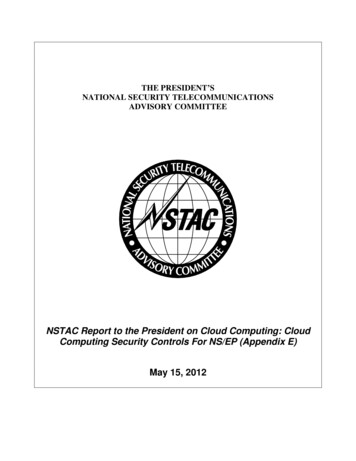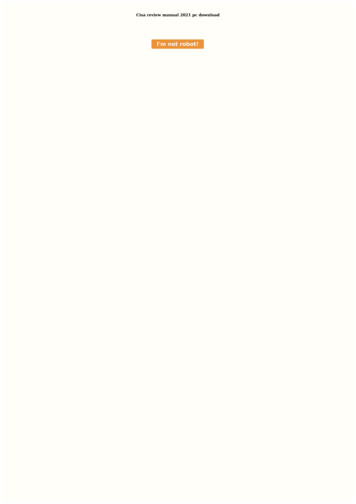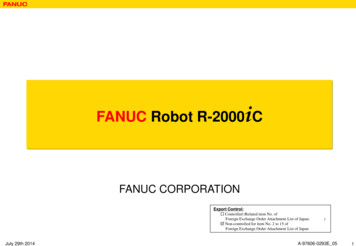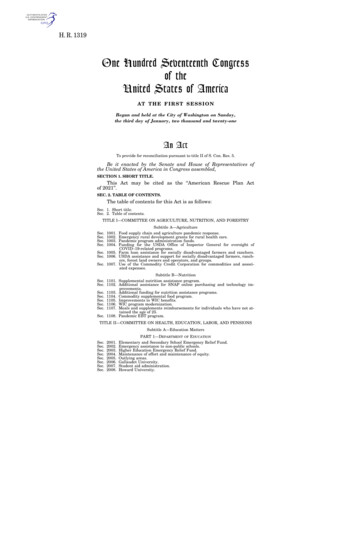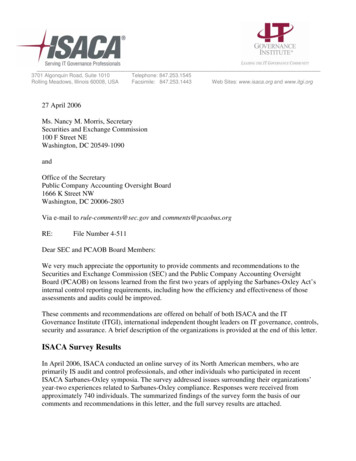
Transcription
3701 Algonquin Road, Suite 1010Rolling Meadows, Illinois 60008, USATelephone: 847.253.1545Facsimile: 847.253.1443Web Sites: www.isaca.org and www.itgi.org27 April 2006Ms. Nancy M. Morris, SecretarySecurities and Exchange Commission100 F Street NEWashington, DC 20549-1090andOffice of the SecretaryPublic Company Accounting Oversight Board1666 K Street NWWashington, DC 20006-2803Via e-mail to rule-comments@sec.gov and comments@pcaobus.orgRE:File Number 4-511Dear SEC and PCAOB Board Members:We very much appreciate the opportunity to provide comments and recommendations to theSecurities and Exchange Commission (SEC) and the Public Company Accounting OversightBoard (PCAOB) on lessons learned from the first two years of applying the Sarbanes-Oxley Act’sinternal control reporting requirements, including how the efficiency and effectiveness of thoseassessments and audits could be improved.These comments and recommendations are offered on behalf of both ISACA and the ITGovernance Institute (ITGI), international independent thought leaders on IT governance, controls,security and assurance. A brief description of the organizations is provided at the end of this letter.ISACA Survey ResultsIn April 2006, ISACA conducted an online survey of its North American members, who areprimarily IS audit and control professionals, and other individuals who participated in recentISACA Sarbanes-Oxley symposia. The survey addressed issues surrounding their organizations’year-two experiences related to Sarbanes-Oxley compliance. Responses were received fromapproximately 740 individuals. The summarized findings of the survey form the basis of ourcomments and recommendations in this letter, and the full survey results are attached.
SEC and PCAOBPage 227 April 2006Primary CommentsBased on our review of the ISACA survey results, the following primary comments wereidentified: Additional guidance for management is needed. The risk-based, top-down approach had nominal impact. Further IT controls guidance is needed. Internal control sustainability is starting to grow as a benefit of Sarbanes-Oxley. Research on automating key controls is needed.The following paragraphs summarize key findings from the survey in support of the primarycomments listed above.Additional Guidance for Management is NeededThe survey asked if the respondents perceived a need for additional management-focused guidanceon Sarbanes-Oxley 404 compliance. More than 80 percent of the respondents either agreed orstrongly agreed that such additional management-focused guidance is needed (question number 1).This area was further supported by the 73 percent who felt that the time is right for separateguidance for management of issuers and for public accountants (question number 3).Recommendation: The SEC should work through COSO and other organizations toensure additional management-focused guidance on Sarbanes-Oxley 404 compliance isdeveloped and made available.The survey respondents identified the following as the top four areas in which additionalmanagement-focused guidance is needed: IT controls (e.g., access, application, change and security) Testing (e.g., requirements, plans, methodologies and sample size) Scoping (e.g., risk assessment, relationship to other controls, processes and subprocesses) Various definitions (e.g., key controls, application and general controls)Risk-based, Top-down Approach Had Nominal ImpactMore than 60 percent of the respondents indicated that the SEC/PCAOB guidance issued in May2005, recommending a risk-based, top-down approach, did reduce the scope of management’s 404work in year two (question number 2). However, 33 percent indicated that it did so by less than 5percent. Nearly 17 percent reported that it actually increased the scope of management’s work.Recommendation: The SEC and PCAOB should work through COSO and otherorganizations to provide additional guidance, illustrations and best practices addressinghow to apply the risk-based, top-down, approach.This finding is consistent with several other surveys released recently by the CRA International 1and Financial Executives International (FEI).2 It appears that the overall resources required havebeen reduced in year two; however, the exact reasons why are not clear. It is apparent the level ofwork performed internally at many issuers is decreasing as they focus on Sarbanes-Oxley as part of12www.crai.comwww.fei.org
SEC and PCAOBPage 327 April 2006a process, and begin to look at their IT risks and controls in the broader context of their ITgovernance efforts.Further IT Controls Guidance is NeededRespondents were asked to identify their best source for addressing IT controls in year two(question number 4); more than 54 percent indicated that they relied on IT Control Objectives forSarbanes-Oxley, published by the IT Governance Institute. Another 46 percent said they utilizedan internally developed approach, while 34 percent used the advice of their external audit firm.Recommendation: The SEC and PCAOB should work through COSO to provideadditional guidance on IT controls. The starting point for developing this guidance couldbe the broadly accepted ITGI publication, IT Control Objectives for Sarbanes-Oxley.When respondents were asked what IT governance/control framework was used for year two(question number 11), 58 percent indicated they relied on Control Objectives for Information andrelated Technology (COBIT) and 30 percent pointed to IT Control Objectives for Sarbanes-Oxley. 3COSO was used by 36 percent and internally developed approaches by 26 percent. More than 52percent reported that their IT control framework was easy to use (question number 12).Internal Control Sustainability is Starting to Grow as a Benefit of Sarbanes-OxleyMore than 57 percent of those responding to the ISACA survey indicated that sustainability wasaddressed as part of their year-two processes or as part of their year-three planning (questionnumber 19). As a result of Sarbanes-Oxley compliance activities, enterprises are making internalcontrol and sustainability a part of their business processes. Additionally, more than 54 percentreported that their overall sustainability efforts included the need for an IT control framework(question number 20). In the organizations’ year-two efforts, more than 50 percent of theirsustainability efforts considered business process, process controls and IT control changes(question number 21).Recommendation: The SEC and PCAOB should work through COSO and otherorganizations to support additional research into best practices and the benefits ofsustainability, including a focus on continuous monitoring and auditing.Research on Automating Key Controls is NeededTwo-thirds of the respondents indicated that less than 25 percent of their key controls wereconsidered automated in year two (question number 23). The possibility exists that the remaining75 percent could achieve additional benefits by automating key controls. As more and more keycontrols are automated, the amount of work should continue to decline for testing and othercompliance-related activities and the effectiveness of controls should increase. Looking at the issueslightly differently, 44 percent of respondents indicated that there was an overall increase in theautomation of key controls from year one to year two (question number 24).3Both COBIT and IT Control Objectives for Sarbanes-Oxley are openly available to the general public from the ISACA andITGI web sites, www.isaca.org and www.itgi.org. The draft of the second edition of IT Control Objectives for Sarbanes-Oxleywill be posted on both sites for public exposure comments from 1 May to 30 June 2006.
SEC and PCAOBPage 427 April 2006Recommendation: The SEC and PCAOB should work through COSO and otherorganizations to support additional research into best practices for automating keycontrols.A Summary of Additional Survey FindingsThe following list summarizes key findings from the survey questions not already referenced in theparagraphs above. The list is organized by question number. Questions 22 and 25 were open-endedquestions and generated a significant number of essay-type responses. Those results, which areunder further analysis, are not included here.5. Almost half of the respondents reported that no time or less than 5 percent of time was savedfor the 404 attestation by having the organization’s management work closer with its publicaccounting firm.6. More than 50 percent of respondents reported that their public accounting firm took entitylevel controls into account in determining their level of testing in year two (question 6.1). For70 percent of those responding to the question, the reduction in work expended by theaccounting firm by utilizing an entity level approach was less than 5 percent (question 6.2).7. More than 40 percent of the responding organizations used software to assist with 404compliance. Many respondents wrote in the name of the software program(s) they used, but noparticular program(s) dominated the responses. In fact, the top three most often namedconstituted only 5 percent of the overall replies.8. More than 40 percent of the respondents indicated that the year-two testing approach differedfrom the year-one testing approach with regard to scope and number of tests. This may explainwhy year-two costs have not decreased as much as anticipated.9. E-mail systems are used by 84 percent of respondents to evidence approvals. Of that 84percent, almost 60 percent did not include the e-mail system in the scope of Sarbanes-Oxley.Additional guidance is needed on the role of controls in these kinds of situations and the extent,if any, to which such controls need to be documented and tested by management and auditedby the external auditor.10. More than 78 percent of those who replied to the question asking about the organization’s ITapproach adopted the same level of IT control for smaller subsidiaries as for largersubsidiaries. (Note: This percentage is based on excluding the “not applicable” responses.)There may be an opportunity to use differentiated approaches based on size, top-downapproach, risk and other factors. This could lead to potential cost reductions.13. More than 56 percent stated that their staff obtained in-house training on using their IT controlframework.14. Of the 620 respondents who relied on external expertise to implement the IT controlframework, 35 percent used a consultant, 35 percent used a Certified Information SystemsAuditor (CISA) or Certified Information Security Manager (CISM), and almost 30 percentused an external auditor.15. More than 37 percent of respondents changed their IT control framework from year one to yeartwo.16. More than 73 percent use spreadsheets as an integral part of the financial reporting process.17. Almost 53 percent use software developed by end users as an integral part of the financialreporting process.18. Only 15 percent use or adapt the nine-firm (public accounting firms) “Conclude framework” toaddress general computer controls and potential deficiencies.
SEC and PCAOBPage 527 April 200626. In year two, more than 58 percent of organizations increased emphasis in testing applicationcontrols.27. Additional comments related to their organizations’ experiences in year two were provided by237 respondents:–More than 28 percent are concerned with external audit and inconsistent guidance.–More than 15 percent are concerned with cost.–More than 10 percent are concerned with testing.–More than 5 percent focused on framework issues.With more than 50,000 members in more than 140 countries, ISACA is a recognized worldwideleader in IT governance, control, security and assurance. Founded in 1969, ISACA sponsorsinternational conferences, publishes the Information Systems Control Journal, developsinternational information systems auditing and control standards, and administers the CISAdesignation, earned by more than 44,000 professionals since inception, and the CISM designation,a groundbreaking credential earned by 5,500 professionals in its first three years.The IT Governance Institute (ITGI) was established by ISACA in 1998 to advance internationalthinking and standards in directing and controlling an enterprise’s information technology. ITGIdeveloped Control Objectives for Information and related Technology (COBIT), now in its fourthedition, and offers original research and case studies to assist enterprise leaders and boards ofdirectors in their IT governance responsibilities.Thank you for this opportunity to relay our comments on the lessons learned from the first twoyears of applying the Act’s internal control reporting requirements. Because ISACA and ITGIrepresent many of the individuals engaged in Sarbanes-Oxley compliance efforts and much of theguidance informing those efforts, we believe we are uniquely positioned to bring value to anyfuture projects to address our recommendations. Please feel free to call on us if we can be ofassistance in any way in task forces, committees or work groups. Representatives of ISACA andITGI will be present at the SEC and PCAOB Roundtable meeting on 10 May in Washington andwe look forward to the discussion of these issues.Respectfully submitted,Everett C. Johnson, CPA2005-2006 International PresidentISACA (www.isaca.org)IT Governance Institute (www.itgi.org)cc: Mr. Larry Rittenberg, Chairman, COSO Board, via e-mail to lrittenberg@bus.wisc.eduAttach: ISACA survey results
3701 Algonquin Road, Suite 1010Rolling Meadows, Illinois 60008, USATelephone: 847.253.1545Facsimile: 847.253.1443Web Sites: www.isaca.org and www.itgi.orgPreliminary ISACA Survey ResultsWith more than 50,000 members in more than 140 countries, ISACA is a recognizedworldwide leader in IT governance, control, security and assurance. Founded in 1969,ISACA sponsors international conferences, publishes the Information SystemsControl Journal, develops international information systems auditing and controlstandards, and administers the CISA designation, earned by more than 44,000professionals since inception, and the CISM designation, a groundbreaking credentialearned by 5,500 professionals in its first three years.The IT Governance Institute (ITGI) was established by ISACA in 1998 to advanceinternational thinking and standards in directing and controlling an enterprise’sinformation technology. ITGI developed Control Objectives for Information andrelated Technology (COBIT), now in its fourth edition, and offers original researchand case studies to assist enterprise leaders and boards of directors in their ITgovernance responsibilities.The following results were generated from an online survey posted from 12 to 15April 2006. The survey addressed issues surrounding organizations’ year-twoexperiences related to Sarbanes-Oxley compliance. ISACA members in NorthAmerica, who are primarily IS audit and control professionals, and participants inrecent ISACA symposia on Sarbanes-Oxley were invited to complete the survey.Responses were received from approximately 740 individuals.The charts below represent the statistical results of the survey. Questions 22 and 25,which were open-ended questions, generated a significant number of essay-typeresponses. Those responses are still being analyzed and are therefore not included inthis document.
SEC and PCAOBPage 2Top four topics suggested for additional guidance were: 292 on controls 105 on testing 84 on scoping 74 on definitions227 April 2006
SEC and PCAOBPage 3327 April 2006
SEC and PCAOBPage 4427 April 2006
SEC and PCAOBPage 5527 April 2006
SEC and PCAOBPage 6627 April 2006
SEC and PCAOBPage 7727 April 2006
SEC and PCAOBPage 8827 April 2006
SEC and PCAOBPage 9927 April 2006
SEC and PCAOBPage 101027 April 2006
SEC and PCAOBPage 1127 April 200622. If your organization relied on manual controls for information generated bycomputer-based reports, how was the evaluation and reporting of manual controlprocedures integrated with IT controls? Responses still being analyzed.11
SEC and PCAOBPage 1227 April 200625. Describe any other significant trends in the results of control testing and subsequentevaluations. Responses still being analyzed.27. Additional comments related to their organizations’ year-two experiences wereprovided by 237 respondents:–More than 28 percent are concerned with external audit and inconsistent guidance.–More than 15 percent are concerned with cost.–More than 10 percent are concerned with testing.–More than 5 percent focused on framework.12
ISACA Survey Results In April 2006, ISACA conducted an online survey of its North American members, who are primarily IS audit and control professionals, and other individuals who participated in recent ISACA Sarbanes-Oxley symposia. The survey addressed issues surrounding their organizations'

